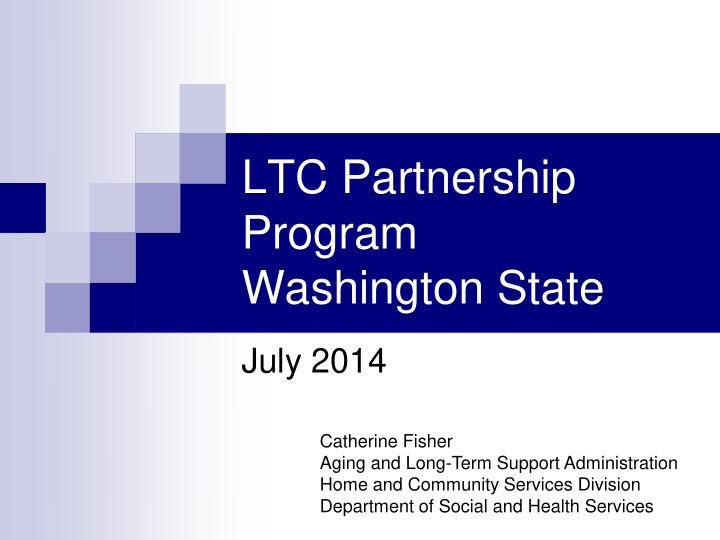



LTC Partnership Program Washington State July 2014 Catherine Fisher Aging and Long-Term Support Administration Home and Community Services Division Department of Social and Health Services
LTC Partnership – Background Section 6021 of the 2005 Deficit Reduction Act expands LTC Partnership opportunities for States by effectively lifting the moratorium on expansion imposed by the Omnibus Budget Reconciliation Act (OBRA) 1993. DRA envisaged a unique Medicaid/private insurance model designed to attract consumers who might not otherwise purchase LTC insurance by allowing them to protect a specified level of assets and still qualify for medicaid. DRA also allowed those protected assets to be protected from estate recovery provisions after the death of the client.
LTC Partnership – Enabling Legislation for WA State In 2008 and 2011, the legislature passed legislation enabling the Insurance Commissioner’s office to adopt the provisions of the NAIC long term care Act and model their LTC regulations by rule as required under the DRA. In December 2011 CMS approved our state plan amendment. Implementation was a cross administration team effort involving many players: Health Care Authority, OIC, ALTSA, State legislature and budget office, insurance companies and agents and the Consumer.
LTC Partnership – How does it work? Policy provides $ for $ asset protection: If policy pays out $100,000, the consumer can protect $100,000 in assets Protected assets are exempt from Estate Recovery. For example, if consumer protects their primary residence, then the home may pass to their heirs without an estate recovery lien.
LTC Partnership – Who is eligible? Must be a resident of WA State when coverage becomes effective under the policy. The policy issue date must be after December 1, 2011 (when our SPA was approved). The policy must have been approved as a partnership policy by the OIC under Chapter 184-83 WAC. The policy must include inflation protection (varies based on the age of the insured). The consumer must still meet all other Medicaid eligibility criteria when/if they apply.
LTC Partnership – who should buy? Consumers with assets or a primary residence they want to will to others. Consumers who want the benefits of paying privately for nursing home care, but need the assurance of the medicaid safety net in case they exhaust policy benefits. Not a good fit for low income families who would already qualify for medicaid. Not a good fit for high income families who can afford to pay privately for care.
LTC Partnership – Benefits Helps clients conserve resources and not have to spend down to the current medicaid asset limits: Single: $2000 Married couple: $55,016 Discourages impermissible transfers of assets to qualify for Medicaid. Consumers can protect assets for estate planning and inheritance purposes. Portability – policies sold in one State are accepted in any other partnership State Help States offset rising Medicaid costs for LTC by shifting costs to private insurance – delays clients coming on to medicaid while the partnership is paying out, which offsets medicaid expenditures.
LTC Partnership – Example Joe owns his own home worth $170,000 and has $60,000 in investment accounts. He has a partnership policy worth $200,000 which has paid out $55,000 to date for in-home care. Joe has two choices: 1) Joe’s home is exempt for medicaid eligibility but he could choose to ‘protect’ his home so he can will it to his children. He would have to ‘spenddown’ $58,000 in assets to be eligible for medicaid. OR: 2) He could protect $55,000 of his $60,000 in his investment accounts. His policy would only have to pay out $3000 more for him to be eligible for Medicaid since there is a $2000 resource limit. As the policy continues to pay out, he could then protect equity in his home.
Moving Forward – what next? Some things to think about……….. Marketing and education campaign? Consumers do not believe this is ‘real’ – how can we help educate Washingtonians about this option? Offer to state employees? Is this an option moving forward? Advertising – what is the right age to consider purchasing LTC insurance? What are the real costs of not buying LTC insurance?
LTC Partnership – More Info Alliance for Health Reform – Long-term care Partnerships: An update March 2007: http://www.allhealth.org/Publications/Long- term_care/Long_Term_Care_Partnerships_53.pdf EAZ manual material for staff and consumers: http://www.dshs.wa.gov/manuals/eaz/sections/LongTermCare/LTCPart nershipMainPage.shtml http://www.dshs.wa.gov/manuals/eaz/sections/LongTermCare/LTCpart nership.shtml http://www.dshs.wa.gov/manuals/eaz/sections/LongTermCare/LTCpart nershipFAQ.shtml
LTC Partnership – More Info Guide to Long Term Care http://www.guidetolongtermcare.com/partnership.html CMS Advisory on LTC Partnerships http://www.cms.gov/Regulations-and- Guidance/Legislation/DeficitReductionAct/downloads/BackgrounderPar tnership.pdf
Recommend
More recommend